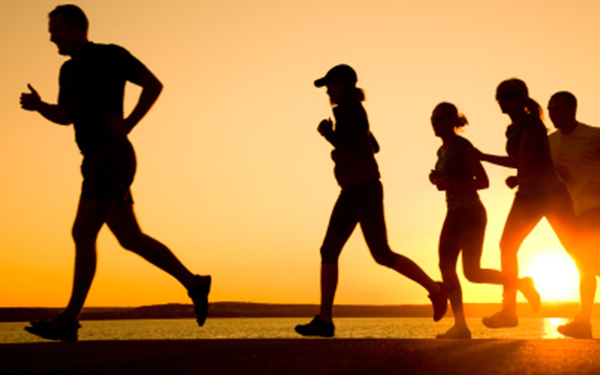Team up: Why working out in groups work
Rate this article and enter to win
Having trouble sticking to your power-walk schedule? If you don’t have a workout buddy or group, it’s time.
College students love the buddy system
What are college students’ top motivators for being physically active? Having an exercise partner and having a friend who works out, according to a 2013 study (along with wanting to look physically fit). Fifty-five percent of participants said buddying up makes it easier for them to work out, and 26 percent listed not having an exercise partner as a barrier to fitness, said researchers in the Archives of Exercise in Health and Disease.
Why it works
Working out in a pair or group introduces multiple elements proven to help us develop healthy habits—like these:
- Cues to action Your friend is showing up whether or not you’re in the mood for aqua spinning.
- Accountability Bailing is not an option.
- Reward Chat, catch-up, laughs, encouragement, and coffee afterwards.
To organize your own group challenges, try SOCIALWORKOUT.COM
Group workouts get us into the habit
Social support is key to improving our physical and mental health and establishing enduring habits, research shows. Physical activity habits at college carry over to midlife, according to a 2009 study. The “supportive social atmosphere” of college exercise programs is likely a key factor, says the Journal of Exercise Physiology.
Activity is contagious
“Social support from friends can be a strong influence on how students spend their leisure time, so the group environment can be a great avenue for improving fitness,” says Dr. Cherilyn McLester, professor of exercise science and sport management at Kennesaw State University Georgia. Make sure your crowd includes some active types. “If our friends work out regularly and support our exercise goals we are more likely to exercise,” says Dr. Xiaomeng (Mona) Xu, professor of psychology at Idaho State University in Pocatello, Idaho, who co-authored a 2011 study on the topic in Psychology of Sport and Exercise.
Four ways to help friends get active- EXERCISE Help establish a social norm and model active behaviors to your peers. Regular exercise (which doesn’t have to be strenuous) can replace less healthy behaviors and become a habit.
- PROVIDE APPROPRIATE SOCIAL SUPPORT when asked. Be more careful if it’s unsolicited. If your roommate says he’s thinking of working out, it is not necessarily helpful to constantly send him exercise tips.
- TALK Discuss what sort of support is helpful (e.g., workout buddy, cheerleader, etc.). Try to match the support you provide with the support that is actually needed. If they can’t exercise because they’d need a ride to a gym, offer that if you can.
- PROVIDE INVISIBLE SUPPORT If your roommate doesn’t have time because she has a lot of errands and chores, do some of these things for her. Don’t say, “Hey, I’m doing this for you so you can go to the gym,” or, “Look how helpful I’m being; you owe me now.” Give her the benefits without bringing attention to it.
- Choose an activity you already enjoy or one you’re interested in discovering.
- Join online groups, forums, or communities that center on your interest.
- Start your own walking, hiking, biking, or running club.
- Look for fitness flash mobs—instances where people announce (via Twitter) that they are meeting at the last minute to exercise.
- For good deals at local studios and fitness facilities, take advantage of Groupon, Living Social, and other internet coupon marketing.
- Your college facilities and classes might be the best in town. Go for it.
Why does this work?
Dr. Xu offers three likely explanations:
- Connection and interaction “For example, I go hiking with my best friend, or, My partner and I both play soccer, and this is something we enjoy talking about even if we don’t play together.”
- Exposure to people like us “Maybe we select friends and significant others who have similar exercise profiles as us. I’m likely to develop friendships with my team members.”
- Exposure to example “Best friends and partners might model exercising behavior for us.”
Calmness in numbers
People who exercise together are calmer and less stressed than those who exercise alone, according to a 2001 study in the International Journal of Stress Management.
Novelty in numbers
“A very common reason for not exercising is boredom,” says Dr. Cedric Bryant, chief science officer for the American Council on Exercise, a non-profit organization promoting physical activity.
“The wide variety of group exercise class formats, music, instructor teaching styles, and interaction with other class participants can help keep you motivated.”

Safety in numbers
Working out with an experienced instructor helps us develop safe exercise habits. “The instructor monitors the class participants to ensure that they are using proper technique and are exercising at an appropriate intensity,” says Dr. Bryant.
What are the options?
Communal workouts aren’t hard to find. Check out community walking programs, Meetup.com, and local fitness classes—which are increasingly likely to include strength training and personal training in groups, as well as outdoor options like park boot-camp and paddleboard yoga.
The November Project—famous for its mass workouts—was designed to encourage New Englanders to stay active during dreary winters, and has spread to 17 locations throughout North America.
Find out more about the November Project.
Online socializing
The dynamism and popularity of social media can help us develop and sustain healthier habits. “Online communities can…promote behavior change,” wrote Dr. Damon Centola, in the journal Circulation last year. “People stay accountable to their fitness goals through Twitter and Facebook, and post fitness selfies to show progress,” says Joy Keller, a group exercise expert and certified personal trainer with the IDEA Health & Fitness Association in San Diego, California.
Check out the Twitter Exercise Motivation Team.
Get help or find out more [survey_plugin]


